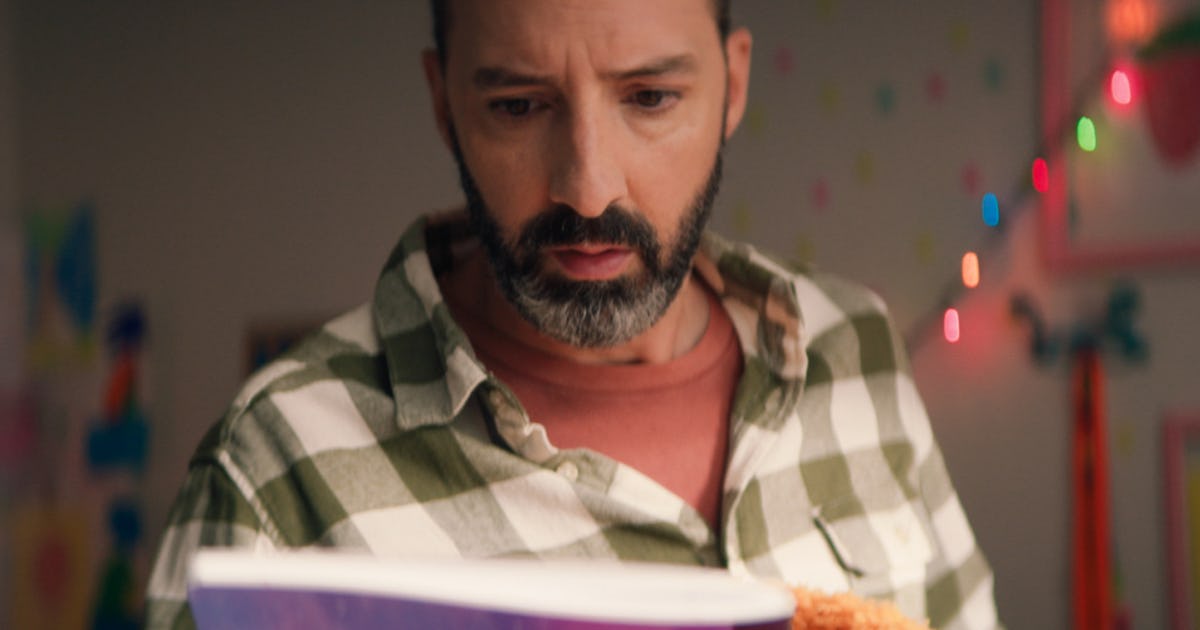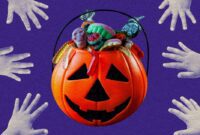Tony Hale has a knack for playing characters you just can’t help but root for — from Arrested Development’s eternally anxious man-boy Buster Bluth to the self-sacrificing “yes man” Gary Walsh in Veep, and even a spork with an existential crisis in Toy Story 4. Now, the Emmy-winning actor is bringing that same mix of heart and humor to the genre-bending family movie Sketch.
Nearly a decade in the making, Sketch is part sincere examination of grief and loss, part supernatural chaos. Think “Inside Out meets Jurassic Park,” says Hale, who plays a widower struggling to help his kids deal with the loss of their mother while also working through his own heartbreak. Then, something wholly unexpected happens: His daughter’s sketchbook, the place she’d poured her pain onto the pages, falls into a mystical pond… and the wildly imaginative (and, admittedly, sort of terrifying) creatures filling it start to come to life and wreak havoc.
You could say it’s a story about monsters. But the soul of the movie speaks to the “big feelings” that come with love, trauma, and growing up — themes Hale connects to deeply, both as the dad in the movie and the real-life dad of a now 19-year-old daughter. I caught up with the actor to talk about the dangers of “snowplow parenting,” the importance of being present, and why everyone he knows is getting a rope bowl (whether they want one or not).
SM: This movie delves into grief and how people cope with it differently. Did that change the way you think about your own emotions?
TH: My daughter’s almost 20, and I just really connected to Taylor, the main character … I’ve been pretty therapized in my life, probably a little too much, and yet I still just want so bad to protect her from challenges. It pains me to watch her have to feel things and go through things, and so I want to guard her against it. But she has to walk through her own challenges. She has to feel her own feelings. She has to be sad, and that’s just so hard to watch, but she’s got to go through it.
I’m sure you’ve heard this new term — I’ve talked about it a lot — called ‘snowplow parenting,’ where you just want to remove every challenge from your kids’ path because it’s just too painful, and I totally, totally get that.
SM: You play a dad whose kids are in the middle of that big feelings era. Did that resonate with you as a parent?
TH: Oh, yeah, and I love that you said the big feelings. I should have been using that this whole time because it’s so true. It’s like the big monsters are a representation of that. They’re so big in the heart and in the mind and the body, and it’s like you just don’t know what to do with them. So them coming to life, you’re like, ‘Whoa.’ Dave is, like, big. That’s a big feeling and kind of putting that in monster form.
SM: The visual representation of these creatures was incredible.
TH: [Writer/director] Seth Worley is so gifted at what he does, because you could see what Amber was using to draw in the monster. You can see the chalk, you can see the crayon, the wax, the Sharpie — those kinds of details are just … so beyond my skill level.
SM: I also thought it was interesting that the kids would identify what each monster was drawn with to figure out a way to dismantle it, which felt like such a cool, deeper message about figuring out how to process certain emotions.
TH: You need to go on this press tour because you’re describing this much better than I am. That is so good. That’s so true.
SM: And these kids! Man, they are amazing. What did you enjoy most about working with the young actors?
TH: I love working with kids in general because there’s just an openness to them. And these two kids specifically, it reminded me of when — my God, 23 years ago — I started on Arrested Development and met Alia Shawkat and Michael Cera. They were just kind of little adults because of their timing and their authenticity when they would perform. I was like, ‘Wow.’ These kids are very much like that. They just really had, not just this kind of maturity, but a sincerity to their maturity that I was just constantly impressed by.
SM: There’s a great line: ‘You can’t control your inbox, but you can control your outbox.’ What does that mean to you? Do you have any other little ‘isms’ you use?
TH: Again, I’m way too therapized, so I have way too many. But that inbox, outbox — I use that a lot. Because I’ve struggled with anxiety in my life and with staying present, one thing I remember a therapist telling me was, ‘You have to wake yourself up a hundred times a day to where you are.’ A way to do that is to kind of activate the five senses: What am I hearing, seeing, smelling, tasting, touching right now? It’s like right where I am just to ground me, and I find myself just having to do that all the time.
And this is really cheesy, but my most recent one is — because in this business you kind of get a lot of ‘What’s next for you?’ — I’ve changed it to what’s here? Just that’s not my default. My default is in the future; my default is to be somewhere else.
SM: I struggle with that, too. In the movie, your daughter processes her grief through art. Have you ever found creativity to be a coping tool?
TH: Yeah. I’ve always wanted to paint, but I’m not a painter, so during COVID, I started creating these rope bowls where you paint the rope and then build these rope bowls out of it.
Then I started making ornaments and all this kind of stuff, and I genuinely give them to my friends even though they don’t want them. I’ll be like, ‘What’s your favorite color?’ They’re like, ‘No, Tony, this is the second one you’ve given me.’ I’m like, ‘Well, you’re getting another one.’ It’s too much fun for me. My family, my friends, neighbors, people I don’t know are so tired of getting them, but they’re going to keep getting them.
SM: You get a rope bowl and you get a rope bowl — everybody gets a rope bowl!
TH: I did this show in Italy for six months, two years ago, and my family wasn’t with me. I was going back and forth, and there’s a picture of me in this little Airbnb I had in Italy with 30 rope bowls. Thirty rope bowls on a table.
SM: 30?!
TH: I handed them out at the end of the show to the cast and to the crew, and I mean, it was just a table of therapy that I did for six months.
SM: Well, now including Taylor in Sketch, you’ve played some truly memorable characters that are both awkward and endearing — with Arrested Development’s Buster Bluth among the most iconic. I’m sure people still quote lines at you all the time. Is there one you hear the most, and do you lean into it? Or do you just sort of grin and bear it?
TH: No, I love it when people come up to me and, with both Arrested and Veep, they say their favorite moments, because I forget. I don’t really have the best memory … The one thing I watch the most of is gag reels or blooper reels; those are the memories that I most enjoy.
The line that’s probably quoted the most is, ‘We’re blowing past nap time.’ Every time someone does it, I’m always like, ‘Gosh, that really was such a funny show.’ What Mitch Hurwitz created, and Armando Iannucci with Veep, I’m so grateful to even have been a part of it.
SM: If there were a Sketch 2, which of your past co-stars would you bring in?
TH: That’s really good. Well, one of Buster’s famous lines is, ‘I’m a monster,’ so maybe Buster himself would be a monster … I mean, it’s hard. I love them all so much. It’s so funny, right when you said that, I put them in monster form. I think Selina Meyer was such a monster, and I’m like, ‘What would Selina’s monster be?’ Just like some presidential crazy person. Right when you asked, I didn’t even think of a real person. I thought of monsters, because those characters were all such monsters.
SM: You could switch from rope bowls and do paintings of people as monsters… Next gift idea.
TH: That’s my thing. Get ready, Julie. You’re going to be getting a painting. You’re going to be getting five paintings of monsters. That’s going to be my new medication.
SM: A series.
TH: Exactly.
SM: You’ve done comedy, drama, animation, and now a genre blend like Sketch. Is there a type of role or project you haven’t tackled yet that you’d love to try?
TH: I still have that 25-year-old-looking-for-a-gig actor in me, so I’m always just so grateful for any gig. I don’t know; I really don’t have one. Anytime I’m doing something, they all feel so unique. And nowadays, to your point, you see a lot of dramedies, and so there’s such a mix of things. If I’m honest, I always kind of look for hints of the comedy within dramas. Because I feel like that’s life. That’s the melting pot of life.
SM: There’s your therapizing in action — you stayed in the here and didn’t jump to the next.
TH: Yeah … thank you for trying to take me out of the here, Julie.
SM: I almost ruined it, but you did good. OK, last question — what is the one thing that you really hope audiences walk out of Sketch feeling or talking about?
TH: Goonies was my favorite film growing up, and I remember it was such a family experience — the parents were having a good time, and the kids were having a good time. I just loved that, and I do want families to have a blast.
At the same time, when I saw Goonies and the kid had asthma, I was like, ‘I’ve got asthma. Oh man, he’s my people.’ So, I love that kids maybe feel seen if they’re kind of going through big feelings. It’s like, ‘Yeah, everybody’s got them.’ Because I think the biggest lie we hear is that we’re the only person going through something — especially kids when they don’t have enough experience in life to know that yet. It’s like, ‘She’s going through some big feelings. I am too. I feel seen.’
Then also, for parents, just to give ourselves a break. This is a learning curve for us all. And the dad, who probably everybody around him was like, ‘What are you doing, man?’ He just didn’t even see it because he was trying so hard to protect his kids, and he’s a good dad. He’s a great dad. So, that thing of just like, ‘We’re all in this process together.’
This interview has been edited for length and clarity.
Disclaimer: This content was automatically imported from a third-party source via RSS feed. The original source is: https://www.scarymommy.com/entertainment/tony-hale-interview-sketch-movie-big-feelings. xn--babytilbehr-pgb.com does not claim ownership of this content. All rights remain with the original publisher.



